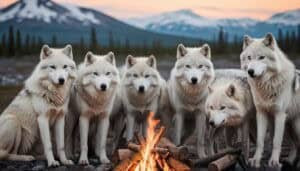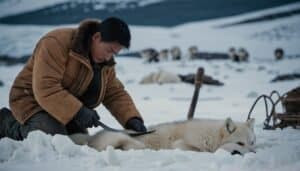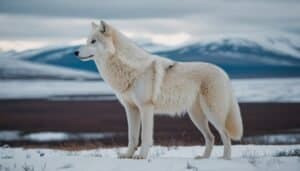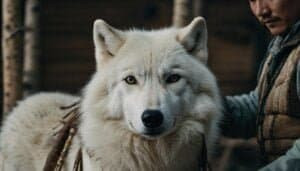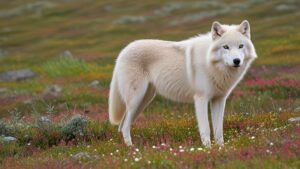Introduction
Traditional Arctic wolf-bone crafting techniques are an integral part of indigenous Arctic cultures. These practices involve a variety of methods and tools to transform wolf bones into useful and symbolic items
This article explores the tools and techniques used, the processes of sourcing and preparing the bones, and the cultural significance of these crafts. We will also examine how these traditions have evolved over time, maintaining a delicate balance between preservation and adaptation in the modern world
Tools and Techniques in Arctic Wolf-Bone Crafting
Traditional Arctic wolf-bone crafting techniques encompass a range of methods and tools used by indigenous communities to create functional and decorative items
These techniques have been passed down through generations, reflecting the resourcefulness and deep connection of Arctic peoples to their environment
Traditional Tools
The tools used in traditional Arctic wolf-bone crafting are often made from natural materials available in the region. Indigenous artisans have developed specialized tools to work with wolf bones, ensuring precision and efficiency in their craft
Types of Tools:
Ulu: A versatile knife with a curved blade, traditionally used by Inuit women. The ulu is used for a variety of tasks, including skinning animals and cutting bones. Its design allows for efficient and controlled cutting
Bow Drill: This tool is used to create holes in bones. It consists of a bow, a spindle, and a bearing block. The bow is moved back and forth to rotate the spindle, which drills into the bone
Bone Chisels and Scrapers: These are used for shaping and smoothing bones. Chisels can carve intricate designs, while scrapers help remove marrow and other residues from the bone surface
Tool-Making Processes
The creation of these tools is an art in itself. Artisans use materials such as stone, wood, and sinew to craft their tools
The process involves several steps:
Selecting Materials: Choosing the right materials is crucial. Stones like flint or obsidian are preferred for their sharpness and durability. Wood for handles and sinew for binding are selected based on their strength and flexibility
Shaping: Stones are shaped through a process called knapping, where small flakes are chipped off to create a sharp edge. Wooden handles are carved to fit comfortably in the hand
Assembling: The stone blade is attached to the wooden handle using sinew or other natural fibers. The binding is tightened to ensure the blade remains securely in place
Sharpening and Maintenance: Tools are regularly sharpened using other stones or sand to maintain their cutting edge. Proper maintenance ensures the longevity and effectiveness of the tools
Carving Techniques
Carving wolf bones requires skill and patience. Artisans employ various techniques to achieve different effects, from simple cuts to intricate designs.
Basic Carving Methods:
Incising: This involves making shallow cuts on the bone surface to create simple patterns or outlines. Incising is often the first step in more complex carvings
Whittling: Using a knife or chisel, artisans shave off small pieces of bone to shape it into the desired form. This technique is used to create basic shapes and smooth surfaces
Scraping: A scraper is used to smooth and thin the bone. This technique helps refine the shape and remove any rough edges
Advanced Carving Techniques
Engraving: Deeper cuts are made into the bone to create detailed designs. Engraving requires precision and control, often using fine-tipped tools
Relief Carving: This technique involves carving away the background to make the design stand out in relief. It adds depth and dimension to the bone, creating a three-dimensional effect
Inlaying: Artisans may embed other materials, such as stone or ivory, into the bone to add color and contrast. Inlaying requires careful planning and execution to ensure the materials fit perfectly
By mastering these tools and techniques, indigenous Arctic artisans create functional items such as tools and utensils, as well as decorative and symbolic objects
These crafts not only serve practical purposes but also hold significant cultural value, reflecting the traditions and heritage of Arctic communities
Sourcing, Preparing, and Crafting with Wolf Bones
Traditional Arctic wolf-bone crafting begins with sourcing and preparing the bones, a process that requires respect for nature and meticulous care
Indigenous communities have developed sustainable methods to obtain, clean, and preserve wolf bones before transforming them into various items
Bone Sourcing Methods
Sourcing wolf bones is deeply intertwined with the subsistence activities and cultural practices of Arctic peoples. Wolves are not typically hunted solely for their bones; instead, bones are collected from naturally deceased animals or as by-products of hunting for other purposes
Sustainable Sourcing Practices:
Natural Collection: Bones are often gathered from wolves that have died of natural causes. This practice ensures that the wolf population is not adversely affected by crafting activities
Subsistence Hunting: In cases where wolves are hunted, it is usually for subsistence purposes, such as food or protection of livestock. The bones are then repurposed for crafting, ensuring that no part of the animal goes to waste
Community Sharing: Bones are sometimes shared within the community, especially if one household has surplus materials. This sharing fosters cooperation and ensures that everyone has access to necessary resources
Respect for Wildlife:
The sourcing process is guided by a deep respect for wildlife. Indigenous beliefs often include a spiritual connection to animals, and the use of wolf bones is accompanied by rituals and practices that honor the animal’s spirit
Bone Cleaning and Preservation
Once sourced, wolf bones must be carefully cleaned and preserved to ensure they are suitable for crafting. This process involves several steps to remove impurities and prevent decay
Cleaning Techniques:
Boiling: Bones are boiled to remove any remaining flesh and grease. Boiling also helps to sanitize the bones, making them safer to handle
Scraping: After boiling, any remaining tissue is scraped off using bone scrapers or knives. This step ensures that the bones are clean and smooth
Drying: Bones are thoroughly dried to prevent mold and decay. This can be done by air drying in a cool, dry place, or by placing the bones in the sun
Preservation Methods:
Smoking: In some traditions, bones are smoked to further dry them and add a preservative layer. Smoking also imparts a distinctive color and smell to the bones
Oiling: Applying natural oils, such as seal oil, can help preserve the bones and make them easier to carve. The oil penetrates the bone, preventing it from becoming brittle
Crafting Common Items
Once the bones are prepared, they can be crafted into a variety of items. These items range from practical tools to decorative objects, each reflecting the ingenuity and cultural significance of Arctic artisanship
Tools and Utensils:
Needles and Awls: Thin, pointed bones are shaped into needles and awls, which are essential for sewing and leatherwork
Fish Hooks: Bones are carved into durable fish hooks, an important tool for Arctic fishing practices
Spoons and Ladles: Larger bones are shaped into spoons and ladles, used for cooking and serving food
Decorative Items:
Jewelry: Bones are carved into beads, pendants, and other jewelry pieces. These items are often decorated with intricate designs and hold personal or cultural significance
Sculptures: Artisans create small sculptures of animals, humans, and mythical figures. These sculptures serve both decorative and storytelling purposes
Symbolic and Ritual Objects:
Totems and Amulets: Bones are carved into totems and amulets that hold spiritual meanings. These objects are believed to provide protection, bring good luck, or symbolize clan identities
Ceremonial Items: Certain bones are used in rituals and ceremonies, often decorated with carvings that depict important cultural symbols and stories
The process of sourcing, preparing, and crafting wolf bones is a testament to the resourcefulness and respect for nature demonstrated by Arctic communities. By transforming these bones into functional and symbolic items, indigenous artisans continue to preserve and celebrate their cultural heritage
Cultural and Symbolic Significance
The crafting of wolf bones in Arctic communities goes beyond practical applications; it holds profound cultural and symbolic significance
The items created from wolf bones often embody spiritual beliefs, traditional practices, and social values that are deeply ingrained in indigenous Arctic cultures
Symbolic Meanings
Wolf bones and the items crafted from them carry rich symbolic meanings. These meanings are often tied to the characteristics and the role of the wolf within the ecosystem and the community
Connection to the Wolf’s Spirit:
Strength and Resilience: Wolves are admired for their strength, hunting skills, and resilience. Items made from wolf bones are often seen as embodying these qualities, providing strength and protection to their owners
Guidance and Wisdom: Wolves are also viewed as wise and strategic animals. Crafting and wearing wolf-bone items can be seen as a way to seek guidance and wisdom from the spirit of the wolf
Clan Symbols: In some Arctic cultures, the wolf is a totemic animal representing certain clans or families. Wolf-bone crafts can symbolize clan identity and heritage, serving as important markers of social structure and lineage
Artistic Expression:
Storytelling: Carvings and engravings on wolf bones often depict stories, myths, and historical events. These artistic expressions serve as visual narratives that preserve and communicate cultural knowledge
Aesthetic Value: Beyond their symbolic meanings, wolf-bone items are appreciated for their aesthetic beauty. The craftsmanship involved in creating intricate designs and patterns reflects the artistic skill and creativity of the artisans
Rituals and Traditions
The use of wolf bones in rituals and traditions highlights their importance in the spiritual and cultural life of Arctic communities. These practices are integral to maintaining a connection with the natural world and ancestral heritage
Ceremonial Use:
Ritual Objects: Wolf bones are often used to create objects for rituals and ceremonies. These objects can include ceremonial knives, totems, and amulets, which are believed to hold spiritual power
Sacred Offerings: In some traditions, wolf bones or items made from them are offered to deities or spirits as a form of respect and gratitude. These offerings can be part of hunting rituals, seasonal celebrations, or rites of passage
Cultural Preservation:
Transmission of Knowledge: The crafting of wolf bones is a means of passing down cultural knowledge from one generation to the next. Elders teach younger community members the skills and meanings associated with these crafts, ensuring that traditions are preserved
Cultural Resilience: In the face of modernization and external influences, the practice of wolf-bone crafting represents a form of cultural resilience. By continuing these traditions, Arctic communities assert their cultural identity and autonomy
Evolution and Modern Adaptations
While traditional wolf-bone crafting techniques are preserved, they have also evolved to adapt to modern contexts. This evolution reflects the dynamic nature of indigenous cultures, balancing tradition with contemporary influences
Modern Influences:
Contemporary Designs: Some artisans incorporate modern design elements into their wolf-bone crafts, blending traditional techniques with contemporary aesthetics. This approach allows for creative expression while maintaining cultural roots
New Materials and Tools: The introduction of modern tools and materials has influenced the crafting process. While traditional tools are still used, modern implements can enhance precision and efficiency in carving and shaping bones
Preservation Efforts:
Cultural Revival Programs: Efforts to revive and promote traditional wolf-bone crafting are undertaken by cultural organizations and community groups. These programs aim to document and teach traditional techniques, ensuring their survival for future generations
Market Integration: Some wolf-bone crafts are made for sale in local and global markets. This integration helps generate income for artisans and raises awareness about Arctic cultural heritage. However, it also necessitates careful consideration to avoid cultural commodification
The cultural and symbolic significance of wolf-bone crafting in Arctic traditions highlights the deep connection between indigenous peoples and their environment
Through rituals, artistic expression, and adaptation to modern influences, these practices continue to play a vital role in the cultural fabric of Arctic communities
Conclusion
Traditional Arctic wolf-bone crafting techniques are a testament to the ingenuity, resourcefulness, and cultural richness of indigenous Arctic communities
These practices encompass a wide range of methods and tools used to transform wolf bones into functional and symbolic items, each with deep cultural and spiritual significance. The process begins with sustainable sourcing and careful preparation of the bones, followed by skilled carving using traditional tools such as ulus and bow drills
The items crafted from wolf bones serve both practical and artistic purposes, from needles and fish hooks to jewelry and sculptures. These crafts are not only valuable for their utility but also for their role in preserving cultural heritage and transmitting knowledge across generations
The symbolic meanings associated with wolf bones, such as strength, wisdom, and clan identity, further enhance their importance in Arctic cultures
Rituals and traditions involving wolf-bone items highlight their spiritual significance, with ceremonial use and sacred offerings playing a key role in cultural practices
Despite the influences of modernization, Arctic communities continue to adapt and preserve these techniques, blending traditional craftsmanship with contemporary elements to maintain cultural resilience
In summary, the art of wolf-bone crafting in Arctic traditions reflects a profound respect for nature, a commitment to cultural preservation, and an ongoing adaptation to contemporary contexts
This enduring practice underscores the enduring connection between Arctic peoples and their environment, celebrating their heritage while navigating the challenges of a changing world


